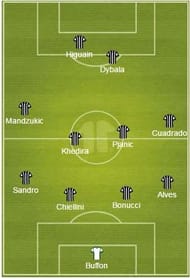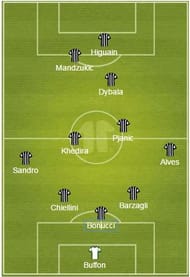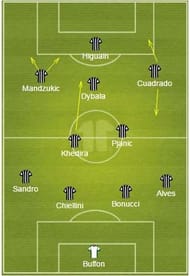Juventus
Defensive Shape
Juventus, primarily, play two formations: either their conventional 3-5-2 or their newly-implemented 4-2-3-1. Regardless of the formation Max Allegri plays the defensive shape always leans towards a narrow 4-4-2, much like Real Madrid’s.
The double pivot of Juventus consists of Miralem Pjanic and Sami Khedira. While this pair has done a good job to replace the famous trio of Arturo Vidal, Andrea Pirlo and Paul Pogba, they lack the defensive steel of their predecessors.
Hence, Allegri had to come up with a solution to play them both in front of the defence while also making sure that the lack of defensive bite isn’t exposed. In both the formations, the players generally align in a 4-4-2 when not in possession of the ball, helping out the midfield double-pivot.
The most important player for Juventus, in a purely tactical sense, is Mario Mandzukic. The Croat is the Old Lady’s first line of defence when they lose the ball. His insane pressing and relentless off-the-ball movement at the top buys Juventus time to take the defensive shape before the opponents find a gap during the transition and hit them on the counter.
Juventus’ defence gets a lot of praise for their outstanding unity, but the truth is that for any club to be a great defensive outfit, the defending needs to start from the top itself—and that is precisely what Mandzukic does.
The 3-5-2/3-4-3
The formation with which they conquered Italy, Juventus’ 3-5-2/3-4-3 has left a lasting presence on the football fraternity, so much that numerous clubs—including even Real Madrid—tried to emulate it.
However, playing a formation like this requires personnel of, in Liam’s Neeson’s voice, very particular set of skills. It is of little wonder that Juventus—the main protagonists of the modern three-man backline—also began to struggle in this formation after the departures of Andrea Pirlo and Paul Pogba.
The usual set up is this: the BBC in the 3-man backline flanked by Dani Alves and Alex Sandro on the wings, Sami Khedira and Miralem Pjanic in the centre, and the trio of Paulo Dybala, Mario Mandzukic and Gonzalo Higuain in attack.
The importance of Pjanic can’t be overstated either as the Bosnian midfielder’s innate sense of passing unlocks a great many defences. The abilities of Mandzukic to hold up play and act as the auxiliary forward is an essential part for this system to work as well.
However, the game-changers in this setup are the full-backs as they play a fundamental role in creating attacks and linking the midfield to the attack. Dani Alves, especially, has been irreplaceably important for the Old Lady when it comes to building attacks.
The 4-2-3-1
Juventus and the 3-5-2 is a love story better than the Twilight series (well, then again, what isn’t). The Old Lady have conquered Italy with that formation for the last five years, but the cracks became highly visible at the beginning of this season.
After playing the system for so many years, teams were starting to figure out the weaknesses in it—especially with the absence of Paul Pogba and Andrea Pirlo. Hence, Allegri had to come up with something, and so he did.
Allegri’s 4-2-3-1 is much like Jose Mourinho’s system with Inter Milan, however with lesser bite. While Inter had some really good physically strong midfielders, allowing them to stand off until the opponent reached their half, Juve rely heavily on pressing up front.
In this setup, the backline usually consists of Leonardo Bonucci and Giorgio Chiellini in the centre of the defence with Dani Alves and Alex Sandro on the flanks. Sami Khedira and Miralem Pjanic make the duo in the double pivot while Juan Cuadrado and Mario Mandzukic flank Paulo Dybala in the hole behind Gonzalo Higuain.
Both Juan Cuadrado and Mario Mandzukic act like the workhorses in attack, constantly harrying and bullying the opposition backline and midfield to not allow them any breathing space or time on the ball while also defensively assisting the double pivot in the process.
Juventus carry their attacks heavily through the overlapping runs of Dani Alves and Alex Sandro. It is almost as if Real Madrid and Juventus are clones of each other in this regard as the full-backs work like playmakers from the deep flanks.
Paulo Dybala, though, has the license to express himself with freedom, something that has brought the best out of him.






